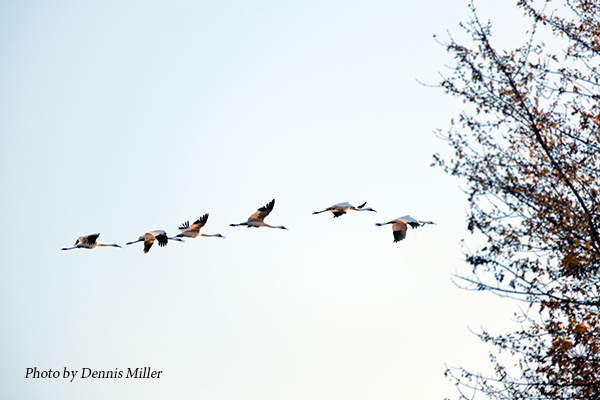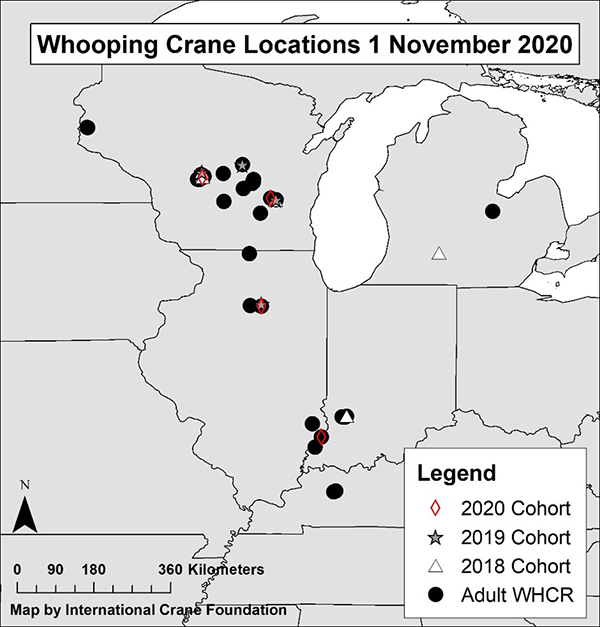
Special thanks to SC Johnson and all supporters of our work to return Whooping Cranes to our skies!
Above, a small flock of Whooping Cranes takes flight on their wintering grounds at Goose Pond Fish and Wildlife Area, Indiana.
Below is the most recent update for the Eastern Migratory Population of Whooping Cranes. In the last month, migration has begun! A huge thank you to the staff of the Fish and Wildlife Service, the Departments of Natural Resources of flyway states, the International Crane Foundation and all the volunteers who help us keep track of the cranes throughout the year. We appreciate your contribution to the recovery of the Whooping Crane Eastern Migratory Population. This report is produced by the International Crane Foundation.
Population Estimate
The current estimated population size is 80 (39 F, 38 M, 3 U). Seventeen of these 80 individuals are wild-hatched and the rest are captive-reared. To the best of our knowledge, as of 1 November, up to 47 Whooping Cranes are in Wisconsin, at least two are in Michigan (although possibly up to four), 10 in Illinois, 12 in Indiana, and two in Kentucky. The remaining birds’ locations have not been confirmed in the last month. Also, migration is underway and the locations of birds change daily! See map below.

Click here to view our interactive “Where are the Whoopers” map for more details.
2020 Wild-hatched Cohort
W3-20 (F) left Wisconsin with parents 11-15 and 42-09 and is currently in LaSalle Co, IL.
W13-20 (M) is still with parents 38-17 and 63-15 at Horicon NWR in Dodge County, WI.
W14-20 (M) left Wisconsin with parents 12-03 and 12-05 and is currently in Knox Co, IN.
W18-20 (F) is still with parents 13-02 and 24-08 at Necedah NWR in Juneau County, WI.
2019 Cohort
W1-19 (F) is possibly still at Necedah NWR in Juneau Co, WI, typically with W10-18 (U) and sometimes also W19_19 (U). She was not detected on the last survey and may have already headed south but has not yet been seen.
W14-19 (F) is still in Portage Co, WI, with 1_17 (M).
W19-19 (U) is possibly still in Juneau Co, WI, with W1_19 (F) and W10_18 (U), although they were not seen on the last survey and may have already left.
79-19 (F) is still in Dodge Co, WI, associating with 16_11 (M) and 74_18 (M).
80-19 (F) is still in LaSalle Co, IL.
2018 Cohort
W3_18 (F) left Wisconsin and is now in Greene Co, IN, with W1_18 (F) and 19_10 (M).
W5_18 (M) was with W1_06 (F) in Juneau Co, WI during late October, but were not seen on the most recent survey and may have already migrated.
W1_18 (F) hadn’t been seen all summer but is now in Greene Co, IN with W3_18 (F) and 19_10 (M).
W10_18 (U) is possibly still at Necedah NWR in Juneau Co, WI is usually seen with W1_19 (F) and sometimes W19_19 (U). They were not detected during the most recent survey and may have already migrated.
W6_18 (M) is now usually alone but is still at Necedah NWR in Juneau Co, WI. He was loosely associating with 16_04 (M) and 2-17 (F) on the most recent survey.
73_18 (F) is still with 3_04 (M) at Necedah NWR, in Juneau Co, WI.
74_18 (M) is still with 79_19 (F) and 16_11 (M) in Dodge Co, WI.
77_18 (M) is moving between Barry Co and Calhoun Co, MI.
Mortality, Long-term Missing
28_08(M) has not been seen for more than a year and is now considered long-term missing and has been removed from population size estimates. He was last seen Oct. 2019 in Wisconsin with his mate 5_10(F) who showed up on the wintering grounds alone and has spent all of 2020 alone on their typical breeding territory.
 Story submitted by Hillary Thompson, North America Program Crane Analyst. Click here to learn more about our work in North America.
Story submitted by Hillary Thompson, North America Program Crane Analyst. Click here to learn more about our work in North America.
